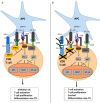Immune checkpoint inhibitors in cancer therapy
- PMID: 28866656
- PMCID: PMC6163118
- DOI: 10.7555/JBR.31.20160168
Immune checkpoint inhibitors in cancer therapy
Abstract
In recent years immune checkpoint inhibitors have garnered attention as being one of the most promising types of immunotherapy on the horizon. There has been particular focus on the immune checkpoint molecules, cytotoxic T-lymphocyte antigen-4 (CTLA-4) and programmed cell death protein 1 (PD-1) which have been shown to have potent immunomodulatory effects through their function as negative regulators of T cell activation. CTLA-4, through engagement with its ligands B7-1 (CD80) and B7-2 (CD86), plays a pivotal role in attenuating the activation of naïve and memory T cells. In contrast, PD-1 is primarily involved in modulating T cell activity in peripheral tissues via its interaction with PD-L1 and PD-L2. The discovery of these negative regulators of the immune response was crucial in the development of checkpoint inhibitors. This shifted the focus from developing therapies that targeted activation of the host immune system against cancer to checkpoint inhibitors, which aimed to mediate tumor cell destruction through the removal of coinhibitory signals blocking anti-tumor T cell responses.
Figures
References
-
- Page DB, Postow MA, Callahan MK, et al. Immune modulation in cancer with antibodies[J]. Annu Rev Med, 2014, 65: 185–202 . - PubMed
-
- Sakaguchi S, Miyara M, Costantino CM, et al. FOXP3+ regulatory T cells in the human immune system[J]. Nat Rev Immunol, 2010, 10(7): 490–500 . - PubMed
-
- Curiel TJ, Coukos G, Zou L, et al. Specific recruitment of regulatory T cells in ovarian carcinoma fosters immune privilege and predicts reduced survival[J]. Nat Med, 2004, 10(9): 942–949 . - PubMed
Grants and funding
LinkOut - more resources
Full Text Sources
Other Literature Sources
Research Materials


